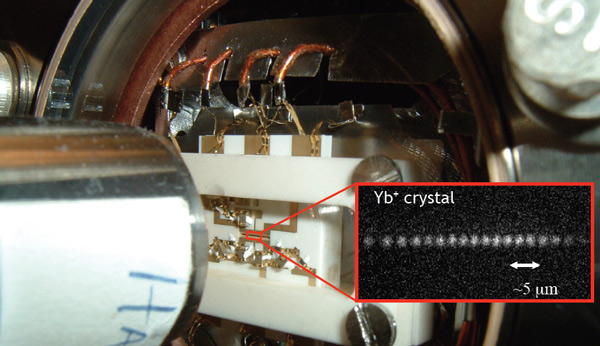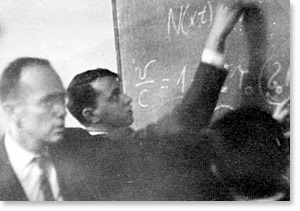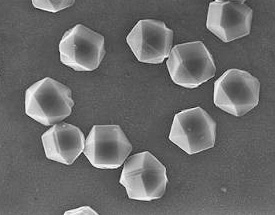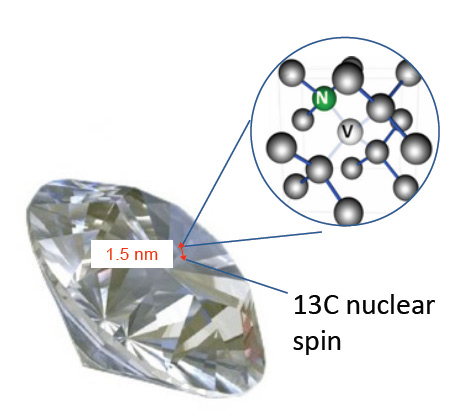The quantum computer still does not come out, but there are a lot of other interesting pieces.
Mikhail Lukin is our compatriot and specialist in quantum physics. Last month, for the first time in the last 20 years, he read a report in Russian, telling Digital October about the essence of his work.

Michael is engaged in quantum computers : while, in fact, the computer does not work, but it turns out many other interesting practical applications, including high-precision sensors and ultra-precise clocks.
')
To explain the essence of what is happening in this area of science, it is worth remembering the history of the laser. Initially, the laser was invented as a kind of scientific toy: amazing, but had absolutely no practical use. For ten years in a row after his invention, scientists joked that this is the answer that is looking for its task. What happened after that - you know: there was a whole sea of tasks, and one of the biggest ones was the transfer of data over fiber-optic systems, which constitute, in essence, the physical essence of the Internet.
At the moment, quantum physicists have several similar "toys", each of which is quite an interesting thing from the point of view of basic science, but has not yet had a pronounced practical application. Here is an example: now you need about 1000-2000 atoms to encode one bit. According to Moore’s law, in 10 years only one atom is required to encode the same amount of information. The classical nature will step aside and quantum physicists will take over, who are already looking forwardto possible investments and evaluating prospects.
Can a single atom store information? In theory, yes. The core and the electron seem to be separate parts, everything, in theory, is similar to the old principles of storing data on hard disks, but simply lies at a lower level ... but in the quantum world, transferring normal processes does not work. In fact, we are resting on the fundamental limit.
If you do not store data in a classic way, you need new mechanics. That is what Michael and his colleagues are involved in. Understanding that new data processing processes are needed opens up new perspectives:

Simplifying, a single quantum object (like a Schrödinger cat) can give up two different data sets at one time. This opens up possibilities not only for constructing new type of drives, but also allows using quantum objects to create new type processors. It is possible to encode several possible states at once into one bit, which allows processing information with a very high degree of overpiling. This idea of quantum acceleration, which is the main idea in the development of quantum computers.
The main problem at the moment with quantum computers - these cells are just hellishly sensitive to external excitations. Accordingly, while one group of scientists is trying to somehow stabilize the microworld, the second group uses these properties and makes the sensor of a new generation, superior in sensitivity to everything that was possible in the world of hundreds and thousands of atoms.
Now the most important thing: how can you write information, read, how to process information stored in individual atoms? It uses the intersection of laser technology and resonance methods (the ones that are used in examining the brain in hospitals). The first studies in this field began in the USSR, in particular, by Vladlen Letokhov, whose ideas determine the development of science so far. In particular, he was the inventor of laser cooling: he figured out how to use a laser to move, detect, and cool atoms. Now systems in which individual ions are stored in a vacuum tube in electromagnetic traps are one of the most likely platforms for the implementation of quantum computers.

Vladlen Letokhov
There are already relatively large by modern standards quantum computers (prototypes), which have 4 qubits and can perform various calculations. It is already clear that on the basis of these studies, we can talk about a revolution in the field of sensors, the emergence of controlled quantum materials, ultrafast data transfer and cryptosystems of the new generation. Will it be possible to assemble a quantum computer in reality? So far, scientists simply do not know the answer to this question, but the attempts have been going on for 15 years already - and if it’s not a computer, then the answers to other tasks are accurate.
For example, quantum sensors and atomic clocks are topics that are already being developed with a huge applied bias. For example, atomic clocks are a key element of the GPS and GLONASS network. The most accurate atomic clocks use quantum bits, which are encoded in chilled ions - exactly the ones that are used now to create a quantum computer. It is necessary to improve the accuracy of the order - and it will be possible to accurately navigate, for example - vehicles without drivers. This is an example of the global consequences of a small scientific achievement. There are hundreds of such examples.
There are two of them now. The first is the exoticism of computers. With an increase in the size of the system from a prototype to a more or less practically-admissible scheme, everything becomes more complicated: for example, with vacuum tubes, the problem of simultaneous isolation and control arises of what needs to be solved. The second problem is the question of what to do with quantum computers in practice: the current level of development implies a very serious instability, which practically excludes any practical use outside the laboratory. Like the laser in the beginning, this is just a toy that promises to be something very serious.
Part of the problem is solved. Mikhail Lukin and his team were able to create a quantum bit that uses the spin of a single core and operates at room temperature. At the same time, the state is maintained macroscopically for a long time (longer than 1 second) - by the standards of quantum physics, it is like a hundred years. The main idea of this work is to use separate atoms that are implanted into diamond samples.
First, it is hard. Secondly, a unique semiconductor with a large band gap. Diamond is also a very good thermal conductor. Two different types of diamond are used in the experiments: grown cube of macroscopic size (many such objects are diamond dust). They are very clean, with almost no impurities. If you add an impurity, it can essentially be comparable to a single isolated atom, such as a separate ion in a vacuum tube. Here the difference is that the atom is stored in a solid-state matrix even at room temperatures. A nitrogen atom is used that replaces the carbon atom in the center of the matrix. It turns out that it is energetically advantageous to have an empty space: this is one of the few impurities in diamond and it has properties very similar to those of an ion.


Diamond nanocrystals
That is, to create a nuclear qubit, a nucleus of carbon isotopes is used. The diamond lattice consists of 2 carbon isotopes with atomic numbers 12 and 13. Only one of them has a magnetic moment, only one of them has a spin, and it can be used as a qubit.

A sample is grown, which consists, practically, exclusively of an isotope with an atomic weight of 12, and after that it is used to measure individual nuclear magnetic moments. The laser focuses it on one of its centers, then the amount of light emitted is measured to measure neighboring nuclei. The amount of light jumps between 2 different levels. Each of these levels corresponds to a specific orientation of the nuclear magnetic moment. It is this discreteness of the light level that show that this system is a quantum system. So, we have a stable model of a quantum system.
One quantum system can live in one state for whole minutes. In order to really make this system a qubit, we need to provide a superposition of states. Recent measurements show us that this quantum memory can be stored for several seconds. This is very important: a normal qubit lives from a million to a billionth of a second. Mikhail believes that the lifetime can be lengthened to minutes, and maybe even up to hours.
Qubits can be individual nitrogen atoms. In a diamond, they can interact with each other. Michael is trying to increase the number of qubits to create a new process. The second scenario is the development of quantum Internet, photons will be used to transfer memory information to the local process.
One of the possible applications is the idea of Stefan Bizner, who started the whole field of quantum informatics. In the year 69, he proposed using quantum bits to make so-called quantum money. The idea of quantum money is as follows: if you encode information in a quantum form, it cannot be copied, but by measuring it correctly, you can confirm its authenticity.
You have a banknote, and there are several quantum bits in this banknote. If someone wants to copy this bill, he will have to measure the orientation of all the quantum bits. If we encode information into a superposition of states, then it is impossible to understand what real state of the qubit was encoded. At the same time, the bank that encoded the information knows what the encoding directions were and can confirm that this is a real banknote.
This is a simple idea, but no one believed in it in the late 60s. Vizner himself tried to publish an article describing this theory for almost 10 years. Now this idea is the basis for the direction of work in terms of storing and transmitting information.
Research shows that it is possible to increase the resolution of tomography to such limits that can be seen on individual atoms or molecules. Mikhail's team assembled a diamond scanning sensor. A separate nitrogen atom is located at the tip: by measuring the properties of this atom according to the procedure described above, one can measure the local magnetic field. In particular, in this experiment a magnetic field was measured, which is created by a classic hard disk with a resolution of about 3 nm. Moreover, it turns out that such experiments can be done even inside living organisms: one can measure magnetic fields and make magnetic tomography of living cells with simply incredible resolution. This, by the way, is very important, for example, to understand how the brain works.
Yes, in Russia there is a Scontel, plus Mikhail knows at least another team that is trying to make a quantum computer.

Michael is engaged in quantum computers : while, in fact, the computer does not work, but it turns out many other interesting practical applications, including high-precision sensors and ultra-precise clocks.
')
What is going on in quantum physics right now?
To explain the essence of what is happening in this area of science, it is worth remembering the history of the laser. Initially, the laser was invented as a kind of scientific toy: amazing, but had absolutely no practical use. For ten years in a row after his invention, scientists joked that this is the answer that is looking for its task. What happened after that - you know: there was a whole sea of tasks, and one of the biggest ones was the transfer of data over fiber-optic systems, which constitute, in essence, the physical essence of the Internet.
At the moment, quantum physicists have several similar "toys", each of which is quite an interesting thing from the point of view of basic science, but has not yet had a pronounced practical application. Here is an example: now you need about 1000-2000 atoms to encode one bit. According to Moore’s law, in 10 years only one atom is required to encode the same amount of information. The classical nature will step aside and quantum physicists will take over, who are already looking forward
Can a single atom store information? In theory, yes. The core and the electron seem to be separate parts, everything, in theory, is similar to the old principles of storing data on hard disks, but simply lies at a lower level ... but in the quantum world, transferring normal processes does not work. In fact, we are resting on the fundamental limit.
The magic word "impossible"
If you do not store data in a classic way, you need new mechanics. That is what Michael and his colleagues are involved in. Understanding that new data processing processes are needed opens up new perspectives:
Electrons and nuclei have a small magnetic moment - spin. It is possible to imagine that an electron or a nucleus is spinning around its axis and because of this rotation it has a certain polarity, it has a magnetic moment. This magnetic moment can be considered as a kind of magnetic memory. In this case, the unit can be encoded into a magnet, which will look up, and a zero can be encoded into a magnet, which will look down. Here, this very simple property allows us to encode a classic bit of information. It turns out that this is a magnetic property of particles, it is, as it were, a quantum object. Quantum laws describe the behavior of particles on such small sizes. It turns out that we can not only write zero and one, we can also write down what is between them, that is, we can write the so-called superposition (combination) 0 and 1. It can be imagined as a magnet that will not turn up or down, but as a magnet, which is turned somewhere to the side. This is a very important property of quantum systems, which allows you to encode not just the classical bit, but the so-called quantum bit of information.

If we apply the laws of quantum mechanics, for example, to the table to this, then, in principle, according to these laws, it is possible to create a state of this table such that it will be in my Cambridge and at the same time in Moscow in Digital October.
Simplifying, a single quantum object (like a Schrödinger cat) can give up two different data sets at one time. This opens up possibilities not only for constructing new type of drives, but also allows using quantum objects to create new type processors. It is possible to encode several possible states at once into one bit, which allows processing information with a very high degree of overpiling. This idea of quantum acceleration, which is the main idea in the development of quantum computers.
The main problem at the moment with quantum computers - these cells are just hellishly sensitive to external excitations. Accordingly, while one group of scientists is trying to somehow stabilize the microworld, the second group uses these properties and makes the sensor of a new generation, superior in sensitivity to everything that was possible in the world of hundreds and thousands of atoms.
And what to do with all this?
Now the most important thing: how can you write information, read, how to process information stored in individual atoms? It uses the intersection of laser technology and resonance methods (the ones that are used in examining the brain in hospitals). The first studies in this field began in the USSR, in particular, by Vladlen Letokhov, whose ideas determine the development of science so far. In particular, he was the inventor of laser cooling: he figured out how to use a laser to move, detect, and cool atoms. Now systems in which individual ions are stored in a vacuum tube in electromagnetic traps are one of the most likely platforms for the implementation of quantum computers.

Vladlen Letokhov
There are already relatively large by modern standards quantum computers (prototypes), which have 4 qubits and can perform various calculations. It is already clear that on the basis of these studies, we can talk about a revolution in the field of sensors, the emergence of controlled quantum materials, ultrafast data transfer and cryptosystems of the new generation. Will it be possible to assemble a quantum computer in reality? So far, scientists simply do not know the answer to this question, but the attempts have been going on for 15 years already - and if it’s not a computer, then the answers to other tasks are accurate.
For example, quantum sensors and atomic clocks are topics that are already being developed with a huge applied bias. For example, atomic clocks are a key element of the GPS and GLONASS network. The most accurate atomic clocks use quantum bits, which are encoded in chilled ions - exactly the ones that are used now to create a quantum computer. It is necessary to improve the accuracy of the order - and it will be possible to accurately navigate, for example - vehicles without drivers. This is an example of the global consequences of a small scientific achievement. There are hundreds of such examples.
What are the problems?
There are two of them now. The first is the exoticism of computers. With an increase in the size of the system from a prototype to a more or less practically-admissible scheme, everything becomes more complicated: for example, with vacuum tubes, the problem of simultaneous isolation and control arises of what needs to be solved. The second problem is the question of what to do with quantum computers in practice: the current level of development implies a very serious instability, which practically excludes any practical use outside the laboratory. Like the laser in the beginning, this is just a toy that promises to be something very serious.
Part of the problem is solved. Mikhail Lukin and his team were able to create a quantum bit that uses the spin of a single core and operates at room temperature. At the same time, the state is maintained macroscopically for a long time (longer than 1 second) - by the standards of quantum physics, it is like a hundred years. The main idea of this work is to use separate atoms that are implanted into diamond samples.
Why diamond?
First, it is hard. Secondly, a unique semiconductor with a large band gap. Diamond is also a very good thermal conductor. Two different types of diamond are used in the experiments: grown cube of macroscopic size (many such objects are diamond dust). They are very clean, with almost no impurities. If you add an impurity, it can essentially be comparable to a single isolated atom, such as a separate ion in a vacuum tube. Here the difference is that the atom is stored in a solid-state matrix even at room temperatures. A nitrogen atom is used that replaces the carbon atom in the center of the matrix. It turns out that it is energetically advantageous to have an empty space: this is one of the few impurities in diamond and it has properties very similar to those of an ion.

Why? Because this impurity emits light. What is shown here is a pure diamond in which individual atoms glow. He also has this spin. There is a magnetic moment about which I spoke already earlier, in which it is possible to encode magnetic quantum information. These impurities can be created starting with a pure diamond simply by bombarding it with nitrogen ions. This is an example of where some ordering is done and a sample created at this Nitrogen-Vacancy color center.

Diamond nanocrystals
That is, to create a nuclear qubit, a nucleus of carbon isotopes is used. The diamond lattice consists of 2 carbon isotopes with atomic numbers 12 and 13. Only one of them has a magnetic moment, only one of them has a spin, and it can be used as a qubit.

A sample is grown, which consists, practically, exclusively of an isotope with an atomic weight of 12, and after that it is used to measure individual nuclear magnetic moments. The laser focuses it on one of its centers, then the amount of light emitted is measured to measure neighboring nuclei. The amount of light jumps between 2 different levels. Each of these levels corresponds to a specific orientation of the nuclear magnetic moment. It is this discreteness of the light level that show that this system is a quantum system. So, we have a stable model of a quantum system.
One quantum system can live in one state for whole minutes. In order to really make this system a qubit, we need to provide a superposition of states. Recent measurements show us that this quantum memory can be stored for several seconds. This is very important: a normal qubit lives from a million to a billionth of a second. Mikhail believes that the lifetime can be lengthened to minutes, and maybe even up to hours.
On the stand - cool, on paper, too, but what's next?
Qubits can be individual nitrogen atoms. In a diamond, they can interact with each other. Michael is trying to increase the number of qubits to create a new process. The second scenario is the development of quantum Internet, photons will be used to transfer memory information to the local process.
One of the possible applications is the idea of Stefan Bizner, who started the whole field of quantum informatics. In the year 69, he proposed using quantum bits to make so-called quantum money. The idea of quantum money is as follows: if you encode information in a quantum form, it cannot be copied, but by measuring it correctly, you can confirm its authenticity.
How do quantum money work?
You have a banknote, and there are several quantum bits in this banknote. If someone wants to copy this bill, he will have to measure the orientation of all the quantum bits. If we encode information into a superposition of states, then it is impossible to understand what real state of the qubit was encoded. At the same time, the bank that encoded the information knows what the encoding directions were and can confirm that this is a real banknote.
This is a simple idea, but no one believed in it in the late 60s. Vizner himself tried to publish an article describing this theory for almost 10 years. Now this idea is the basis for the direction of work in terms of storing and transmitting information.
More applications?
Research shows that it is possible to increase the resolution of tomography to such limits that can be seen on individual atoms or molecules. Mikhail's team assembled a diamond scanning sensor. A separate nitrogen atom is located at the tip: by measuring the properties of this atom according to the procedure described above, one can measure the local magnetic field. In particular, in this experiment a magnetic field was measured, which is created by a classic hard disk with a resolution of about 3 nm. Moreover, it turns out that such experiments can be done even inside living organisms: one can measure magnetic fields and make magnetic tomography of living cells with simply incredible resolution. This, by the way, is very important, for example, to understand how the brain works.
Are there other groups working in this direction?
Yes, in Russia there is a Scontel, plus Mikhail knows at least another team that is trying to make a quantum computer.
Links
- Michael's lecture at Digital October in Russian and English.
- Harvard Center for Quantum Physics (Michael Base)
- Russian quantum center , there are announcements of technologies.
- Vicky about Schrodinger's cat with a footnote, why a cat, and not a cat.
Source: https://habr.com/ru/post/144155/
All Articles